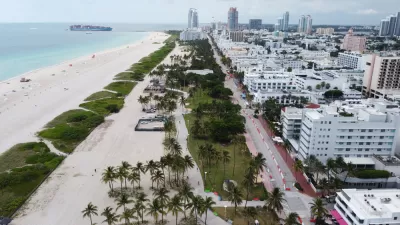In an effort to create safer walking and biking environments, Miami-Dade counties have built bike lanes along two highways connecting the Miami with its eastern island beaches, reducing travel distances by 75 percent for cyclists.
As covered by Tanya Snyder on Streetsblog USA, after years of being ranked the most dangerous state in the United States for walking and bicycling, "state Transportation Secretary Ananth Prasad launched the Bicycle/Pedestrian Focused Initiative and the state is beginning to build more bike lanes and other infrastructure for safe biking and walking. And the experiment in accommodating active transportation on these limited-access bridges is a bold attempt to correct the errors of the past."
Aiming to make cheap retrofits to the existing shoulders on these six-lane, 55 mile-per-hour highways, the "pilot project cost under a million dollars for the two Miami-Dade County bridges together. The most expensive part was adding a hand railing to the wall at the edge of the bridge — there’s no wall between the bikes and the cars. In some cases FDOT and its team painted sharrows and crossings for cyclists to navigate tricky areas like on-ramps, sometimes they added green paint to point out conflict zones. They added rumble strips and striping that would vibrate and make noise if drivers veered out of their lane. They replaced some drainage grates with ones that wouldn’t be dangerous to bike tires."
Many cyclists illegally rode these causeways before the improvements. With the retrofits, cyclist ridership has increased along these highways, with a 40 percent increase in bicycle trips on the William Lehman Causeway, and a 167 percent uptick on weekdays and a 68 percent increase on weekends along the Julia Tuttle Causeway.
FULL STORY: Complete Freeways? Florida Tries Bike Lanes on Highway Bridges

Planetizen Federal Action Tracker
A weekly monitor of how Trump’s orders and actions are impacting planners and planning in America.

Congressman Proposes Bill to Rename DC Metro “Trump Train”
The Make Autorail Great Again Act would withhold federal funding to the system until the Washington Metropolitan Area Transit Authority (WMATA), rebrands as the Washington Metropolitan Authority for Greater Access (WMAGA).

The Simple Legislative Tool Transforming Vacant Downtowns
In California, Michigan and Georgia, an easy win is bringing dollars — and delight — back to city centers.

The States Losing Rural Delivery Rooms at an Alarming Pace
In some states, as few as 9% of rural hospitals still deliver babies. As a result, rising pre-term births, no adequate pre-term care and harrowing close calls are a growing reality.

The Small South Asian Republic Going all in on EVs
Thanks to one simple policy change less than five years ago, 65% of new cars in this Himalayan country are now electric.

DC Backpedals on Bike Lane Protection, Swaps Barriers for Paint
Citing aesthetic concerns, the city is removing the concrete barriers and flexposts that once separated Arizona Avenue cyclists from motor vehicles.
Urban Design for Planners 1: Software Tools
This six-course series explores essential urban design concepts using open source software and equips planners with the tools they need to participate fully in the urban design process.
Planning for Universal Design
Learn the tools for implementing Universal Design in planning regulations.
Smith Gee Studio
City of Charlotte
City of Camden Redevelopment Agency
City of Astoria
Transportation Research & Education Center (TREC) at Portland State University
US High Speed Rail Association
City of Camden Redevelopment Agency
Municipality of Princeton (NJ)



























